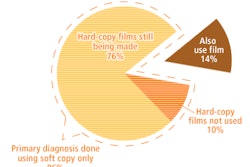Crunched by a variety of factors, such as decreased revenue, the commoditization of imaging, and increased scrutiny of utilization, imaging centers are being challenged simply to maintain business as usual, much less to grow. And key to an imaging center's success is its base of referring doctors.
In this healthcare environment, imaging centers would do well to perform a bit of referral base analysis, according to Brendon Buckley, managing partner for Layer12, a Carmel, IN-based healthcare consulting firm that specializes in medical marketing. Buckley spoke at a recent Radiology Business Management Association (RBMA) marketing conference in Denver, giving attendees concrete ways to survive and thrive.
"Having a good referral base is vital to both the short- and long-term health of an imaging center," Buckley said. "If you don't have a healthy base, you're going to lose business."
Understand your base
It's difficult for an imaging center to develop a strong referral base if it's not clear exactly what that base is and how it "works." Referrals don't come just from doctors, but also from nurses and nurse practitioners, physician assistants, referral coordinators, and administrators, Buckley said.
"What influences referrals? The quality of care you provide, which your referrals assess via patient feedback; the accessibility of your radiologists for questions; quick report turnaround times; and ease of access to image and report data," he said. "And take some time to understand your referral types. Are they strong -- that is, very loyal? Do they refer somewhat regularly? Or do they refer very little?"
Manage and nurture
To protect its referral base, a facility needs both to manage and nurture it, Buckley said. Effective management involves understanding referral patterns. When and why are there drops or bumps in activity? What is the payor mix of the referrals? Does your facility effectively capture referring physician information? Look for referral counts (quarter to quarter and year to year), types of procedures, who isn't referring to your facility, and return on investment for marketing activity.
To nurture the base, start by staying in touch.
"Stay in frequent contact with your referral base," he said. "Understand their business and know their business status, both the challenges they're facing and the opportunities they have. Take some time to understand them personally."
Effective marketing is key to achieving growth, Buckley said. He offered various tips on how imaging centers can boost their marketing buck:
- Choose face-to-face marketing whenever possible.
- Ask each referring party what they look for -- and listen and respond.
- Highlight your facility's strengths through patient testimonials.
- Tailor the marketing message to the specific referring practice.
- Demonstrate the facility's payor relationships.
- Know the medical specialties of your referrers and the service area.
- Reach out to new referring physicians.
- Know the competition.
"Understanding what your facility brings to the table is crucial," he said. "If you can't come up with the factors that differentiate you from your competition, then there's your homework."
Use a client relationship management tool
A client relationship management (CRM) software package helps, Buckley said. An integrated one will track marketing activity, enable personalized contact, and improve an imaging center's targeting. Combine that with top referring physician and practice reports, and your facility has some powerful tools to manage and nurture its referral base, according to Buckley.
"It's important to know who refers to you, but it's even more important to know who isn't referring to you," he said. "You have to have an integrated CRM system to get the most useful information."
It's better to buy a CRM package specifically designed for medical environments, rather than buying a generic one off the shelf and then retrofitting it, Buckley said. A good package will help an outpatient imaging facility track, among other things, current procedural terminology (CPT) codes by modality type, payor mix, dates of service, the billed amount for service, the specialty of the referring doctors, and when they last referred.
"To thrive, you need hard-core business intelligence that actually helps you in your marketing," Buckley said.
By Kate Madden Yee
AuntMinnie.com staff writer
April 17, 2009
Related Reading
The Profit Center: Part 2 -- Steering clear of Stark and false-claims violations, March 31, 2009
Nevada radiology practice to pay $2 million settlement, March 27, 2009
Imaging self-referral: An inside manifesto, March 19, 2009
The Profit Center: Part 1 -- 7 key steps to contract success, March 12, 2009
Radiology groups need new approaches to survive in tough times, January 15, 2009
Copyright © 2009 AuntMinnie.com




















